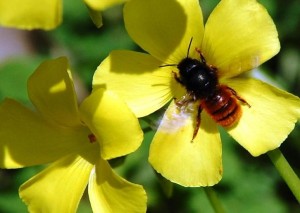TUESDAY, 22 FEBRUARY 2011
Perhaps it is not surprising that plants have evolved multiple lines of defence, as a bee can deplete 90% of a flower’s pollen in a single visit and it requires the nectar of hundreds of flowers to feed just one larva. Head of the study, Claudio Sedivy explains "Bees and plants have conflicting interests when it comes to pollen. While most plants offer nectar to visiting insects as a bait for them to transport the pollen from flower to flower, bees are very efficient pollen collectors. Therefore, plants have evolved a great variety of morphological adaptations to impede bees from depleting all their pollen.”This study shows for the first time that pollen chemistry may be just as important as structural defences [1] . Two species of bee larvae (Osmia bicornis and Osmia cornuta) were fed exclusively with the pollen from one of four plant species – buttercup, viper’s bugloss, wild mustard and tansy. Even though these bee species usually have a diet of several different pollens they showed huge differences in their ability to develop depending on which pollen they received. Neither species could live off tansy pollen and more than 90% of O. comuta larvae died within days of being fed a diet of just buttercup pollen. Bees must adapt to cope with the unfavorable chemical properties of some pollen which may lack essential vitamins, lipids or amino acids.
Written by Jessica Robinson

